Archive for February, 2015
Amanda Cox at Columbia University
Yesterday (2/23/2015) morning I attended a data visualization presentation by New York Times graphics editor Amanda Cox at Columbia University’s Mailman School of Public Health. Amanda presented some great examples from the Times as well as other sources while breaking down her presentation to the topics Scale, Context, Pattern and Annotation Layer. I arrived late and missed the majority of the Scale portion. The following are notes from the presentation…
Make the data open, make it flexible, present a user with an interface to manipulate the presentation of the data, to see the data in various groupings.
The power of text: the most common thing that people do on a page is read and by far it is only the top of the page that people read. Most people do not click on buttons.
The example that Amanda presented regarding pattern is “Mapping America: Every City, Every Block”
Form is key to revealing patterns – use of familiar geography to superimpose information employing color, shading, shape and size. In geographic placement of data regarding the House District results one may quickly grasp that urban versus rural areas is decisive.
Annotation Layer
Annotation should be minimal, no more than a layer of pointers or outlines or brief notes superimposed onto graphics be it image or video. Amanda momentarily turned it over to a video interview with NY Times Science Graphics Editor Jonathan Corum:
She then presented a brief video documentation explaining aerial skiing by United States Olympic aerialist Ryan St. Onge and science reporter Henry Fountain in which extremely simple annotation is superimposed on to the video to make important points. She also compared this very simple graphic with and without annotation – “graphs are stronger when they say something” – Amanda Cox.

Peak Break-Up Times without Annotation
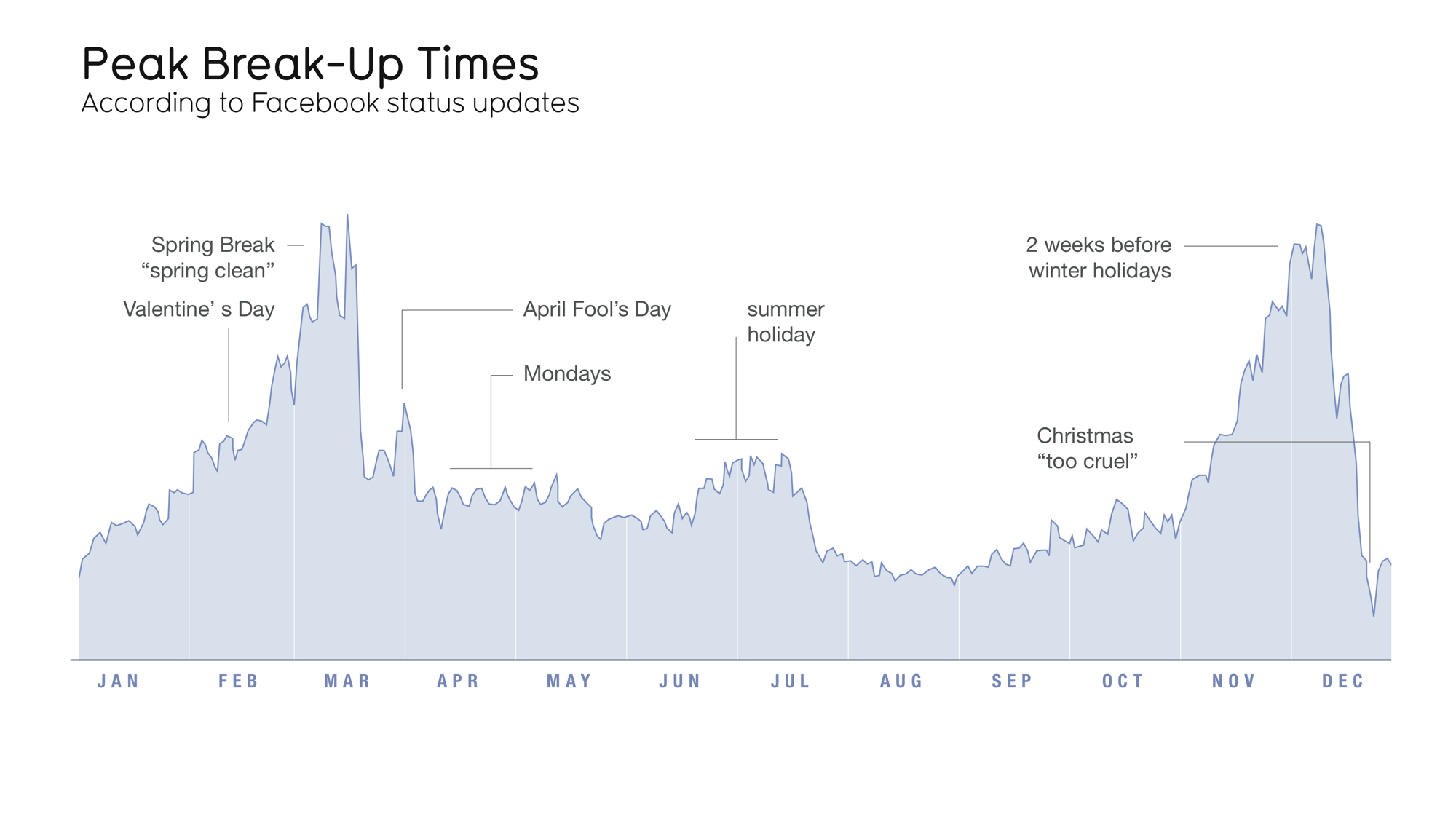
Peak Break-Up Times with Annotation
An example of the using annotation to illustrate different ways of looking at data is the NY Times “One Report, Diverging Perspectives” – a visualization of the last jobs report before the 2012 elections. The visualization allows one to view the report with “Democratic Goggles” and “Republican Goggles.” The data is the same and both interpretations are true, however the manner in which the data is interpreted depends one’s perspective.
Amanda Cox showed varying forms of engagement through the representation of data. In “All the Medalists: Men’s 100-Meter Sprint,” the reports begins the page with a 3D video animation that depicts the change of speed of gold medalists in the 100 meter run from 1896 to 2012. Following the video the page scrolls down to scatterplot displaying the same information. Of course, the time based animation will engage the viewer very differently than the static scatter chart.
The final example that Amanda Cox presented was a the superimposition of two separate data visualizations to present a cultural and historical reality of the United States. One was a visualization of the Republican versus Democratic votes in the 2012 Presidential Elections from southern states. The pro-Obama areas presented an arch of concentration that presented strong similarities to a very old visualization of cotton farms across the same states. When these two visualizations are collapsed one over the others, a strong sense of history regarding the present is established as the areas that were once cotton farm areas voted strongly for Obama.
Amanda made a point that beyond interactivity and cool graphics is the strength of the content. If one has minimal resources, focus on the content and in depth research. Practically, with so many people looking at the web on their phones, a simple text and image may be much more effective than an immersive experience.
“The Surrender” by Stephen Maing
“The Surrender” by Stephen Maing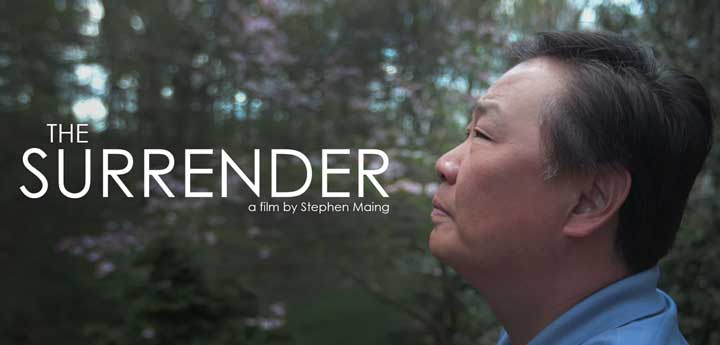
Occasionally, I see something that makes me reconsider the Libertarian platform as perhaps not being so ridiculous. The latest something to do so is the short documentary by Stephen Maing titled “The Surrender” which is currently available on First Look Media.
A simple conversation between Stephen Kim an intelligence analyst in the State Department and an ignorant Fox reporter James Rosen lead to the prosecution and 13 month prison sentence of Stephen Kim. The basis of this prosecution is a report that a UN Resolution would lead to further nuclear tests by North Korea. As Jon Stewart put it “that’s it, that’s the leak… North Korea has a nuclear test based economy.”
A good man looses his life savings fighting ridiculous accusations by the Obama administration using the Espionage Act to try and dig up whistle blowers. It’s difficult to not consider whistle blowers as the agents for a transparent government, one of the values espoused by Obama.
Why are our tax dollars going toward the conviction of innocent people who are trying to help build a better world? Of course Libertarian ideals and the desire to contribute toward a better government and country are at odds. Immediately after reconsidering Libertarianism, I recall… “oh ya, Libertarians must be land-owning white people who are pissed about taxes, like to have their guns and feel strongly that they had nothing to do with slavery or its aftermath. They probably home school their children and are against vaccinations.”
Once Stephen Kim’s prison term is up, he must show proof of employment. Later this year Stephen Kim will go from highly regarded State Department Analyst to a Beauty Product Salesman (Kim secured his employment at a beauty supply store before heading to jail).
Charif Kiwan of Abounaddara collective at Hunter College
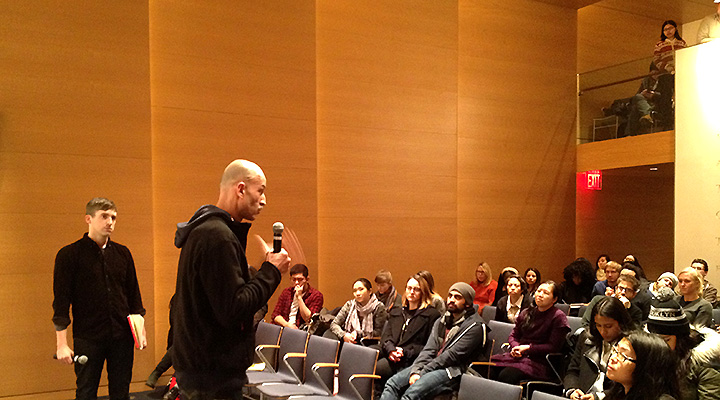
Charif Kiwan of Abounaddara collective at Hunter’s Roosevelt House in discussion with Jason Fox and Hunter students, 19 February, 2015
Hunter College Media Studies professor, Jason Fox invited Charif Kiwan of the Abounaddara Syrian video collective to screen a compilation film and speak with Hunter Students. The evening made for a powerful and eye-opening exchange.
Inspired by Dziga Vertov’s “Man with a Movie Camera” (1929), Abounaddara is Arabic for “man with glasses.” Charif Kiwan is the collective’s representative who no longer lives in Syria and has no plans to return. Osama al-Habali, one member of the collective has been imprisoned for the past year and a half, however the collective continues with its mission to produce and post one video a week depicting Syrian life at a time of war.
As Charif described the work of Abounaddara, the collective’s goals are simple:
1. Produce and post one video per week that captures Syrian life at this time of war. Kiwan referred to this practice as “emergency cinema.”
2. Defend the “right to the image” as a basic human right.
The outcome of these goals are to inform and motivate others to find a way to help a people in crisis and to create an archive that portrays every-day life in Syria at this moment. The French-German television network arte commissioned the nearly hour-long compilation of Abounaddara’s videos that was screened at the Roosevelt House.
Although Charif claimed that the anonymous video collective attempts to capture all sides of Syrian life and in doing so give voice to members within the Bashar al-Assad regime and the Islamic State as well as to the rebels and the victims of the ongoing conflict, the compilation is most strongly a call to end the violence and suffering.
Amongst the most powerful shorts in the compilation are “Children of Halfaya” and “SYRIA: Snapshots of History in the making” both are embedded below. “Children of Halfaya” captures boys in a refugee camp in Lebanon, the oldest boy recalls bombing massacres, including that of his school. And “SYRIA: Snapshots of History in the making” captures a young man retelling the moment that he became an activist and the empowerment of protest, however, he must pause as his interview is interrupted by bombing.
Children of Halfaya from abou naddara on Vimeo.
Syria : Snapshots of History in the making from abou naddara on Vimeo.
Whereas other videos posted to Vimeo, merely capture moments in everyday life, such as young people enjoying a street concert (this video was not included in the compilation):
The Wall from abou naddara on Vimeo.
Charif Kiwan pleaded to the audience to act, to engage and to work toward a better world. The video compilation captured diverse perspectives, however, the message appeared clear – the United States must intervene in Syria. It is the moral imperative to end the killing. Charif stated that Syrians are strongly against imperialism, and he seemed to imply an understanding of the price that a U.S. intervention would cost Syria and it’s culture. The current reality of human massacre, suffering and exodus necessitates intervention by foreign powers.
Notes on “The Fear of Art”
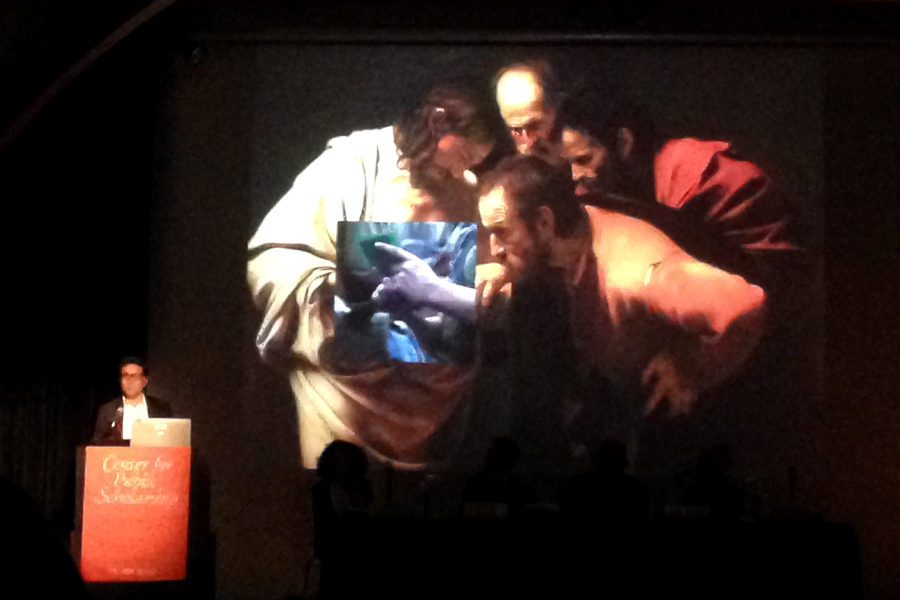
Jack Persekian – Caravaggio collaged with contemporary Palestinian reality.
Today, February 13th 2015, I attended the last two sessions of the New Schools “The Fear of Art” two-day conference. I have a few notes from the last panel.
Jeffrey Deitch: on mural of coffins with dollars by Blu… I’m sure that Jeffrey is familiar with the term “parachute artist”… why in this day and age would a museum and an artist create public work ignorant of the immediate community? It seems so unprofessional, disrespectful, naive, ignorant… inform oneself before creating a work, particularly a work destined for the public space. Some veterans protested against the white washing of the wall. They believed in what the mural portrayed – the union of money and war.
In the end a problematic image that created public outcry was short lived… It sounds like our mass media cycle – is this as art should function or the type of work and outcome that a museum desires? Deitch leaves it up to the artist, and that seems too easy. It is the makings for a lot of bad art getting a good run. What about the question of the maturity of the artist. By maturity, I mean an artist undertaking the responsibility to inform oneself, to talk with people, to do research and consider the nuances of a neat visual idea. If an artist informs herself and then proceeds with the work, great, but if an artist runs with a strong visual idea without carefully considering the meaning from various perspectives… then should this type of work be supported? Can research lead to self-sensorship?
Boris Groys: at museums pray to religious artifacts… always imagine what an ancient Egyptian or Greek or Aztec would feel or think if visiting a contemporary museum with these artifacts.
To offend people is a good thing to do because it provokes a reaction, it makes clear the attitude, it puts things on the table.
Lisa Phillips: the strongest art is disrespectful, problematic, because it’s a new way of seeing, a way of seeing that is disruptive and exists before entering the mainstream and being accepted.
Jack Persekian: Installation in preparation for the Pope’s visit to Palestine, images that merged Baroque art with current life of Palestinian’s… what we think of the Holy Land and what it means to live in the location… Carvaggio – Thomas asked to touch Jesus’s wounds – switched to identity card used to scan the finger print of Palestinian’s. The work turned out to be too confrontational to be presented to the pope.
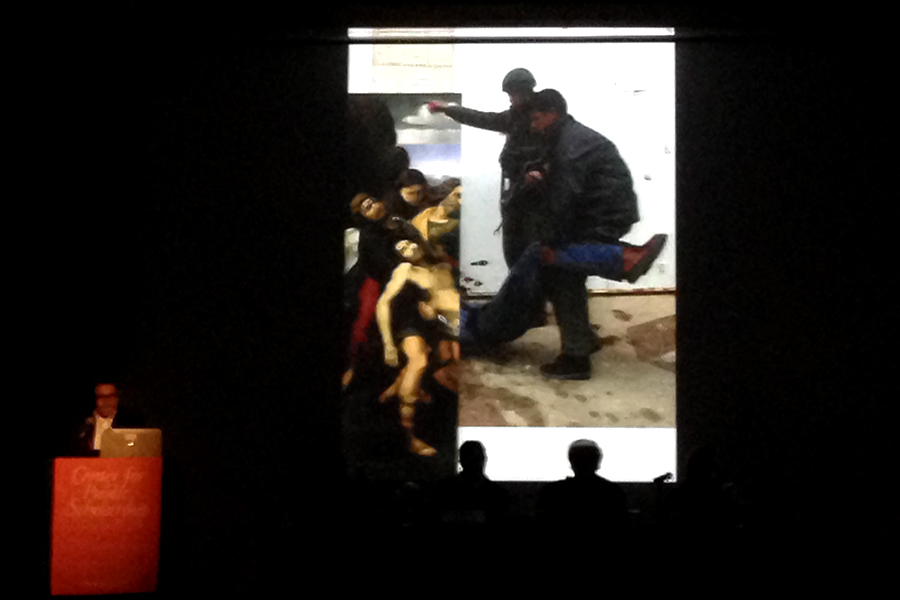
Jack Persekian – Baroque painting collaged with current Palestinian reality
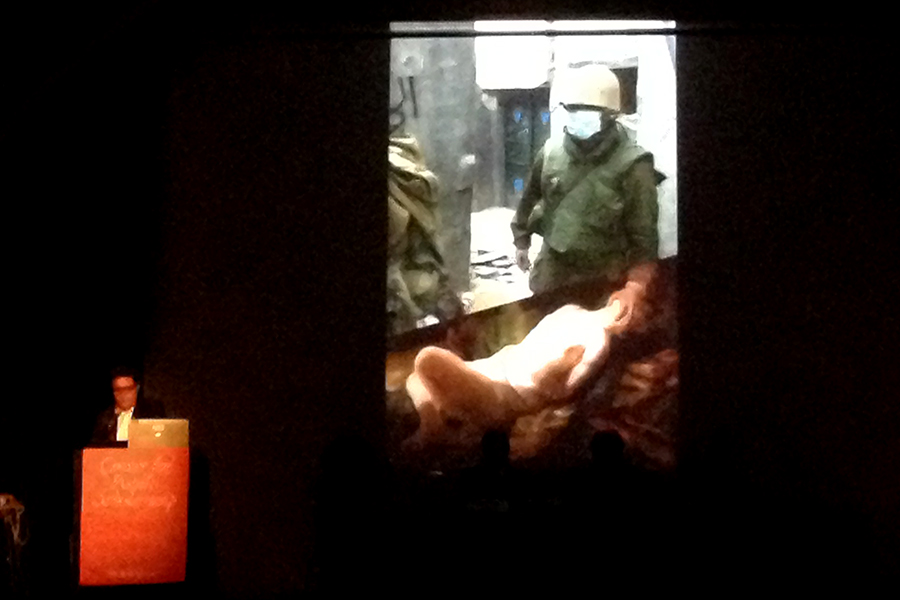
Jack Persekian – Baroque painting collaged with current Palestinian reality